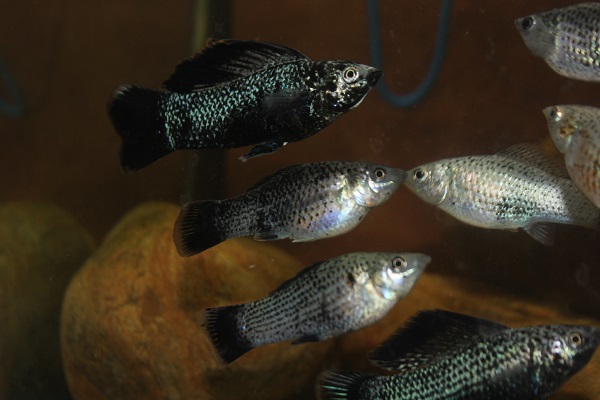Photo shows a shoal of Midnight Blue Sailfin Mollies.
This molly, the Midnight Blue Sailfin Molly, is a relatively new creation of ours, but it has a long pedigree.
I’ll quote myself in an article published in Tropical Fish Hobbyist magazine.
“In October 2008 I set up a test cross of Poecilia petenensis, one of three wild sailfin molly species, with our gold wag lyretail sailfin mollies. At that time I was hoping to improve the lyretails in our mollies and thought P. petenensis might help since one of our strains of that species had a short “sword.” Ultimately, that proved to be a vain hope. Despite the lack of improvement in the F1s (first generation of hybrids), I persisted and raised large number of F2s and F3s. Even rearing large numbers of fish and persisting through three generations, the lyretails weren’t improved. Realizing my original purpose wasn’t going to be met, I almost discarded the line. But being persistent (read stubborn), I kept the line going and in the fifth generation some interesting fish serendipitously popped out. These fish were light gold with opalescent bellies. They weren’t very attractive, but they were interesting. That was enough for me to try one more generation. The opalescent fish were set up for breeding.
In another example of serendipity and also the result of raising hundreds of fish each generation, the F6 generation produced two males and two females with blue on almost white bodies with black patterning in the fins and on the body. This was an unexpected result. They were dubbed “blue freckle sailfin” mollies. Blue for the blue color and freckle for the black freckling. The four fish were given their own breeding vat.
That’s where we were in May 2013… Since that time we’ve gone through two additional generations. In the process, we’ve discovered the white body breeds true; it must be a recessive gene. Also we’ve discovered most of the offspring are blue freckles, but we also get fish that are just white with no freckles or blue color. It appears the blue color might be linked to freckling. The fish colors fall into four categories 1) white (very similar to silver mollies), 2) blue freckle, 3) much darker fish that Ashley, our hatchery technician responsible for livebearers, calls “midnight blue,” and 4) white fish with gold overtones. We purge the white fish. The fish with gold overtones have been segregated and we are working on a fish we call the “silver bronze” molly. The midnight blues only appeared in the last generation.”
That article brought us up to June 2014, about a year ago. Since that time we have continued working with this strain. Last week we processed this strain again. The photo shows two males and five females of our new breeding colony. The males are young and will grow larger dorsals. The strain doesn’t yet breed completely true; we still get some blue freckles and silvers. We hope to improve the blue color. I imagine a deep blue with the black filigree. It’s also interesting that the females especially show a wag pattern, black fins.
Once we’ve set the strain we’ll begin distributing this fish to the hobby, may be in the next couple of generations.
Good fishkeeping!


Mujtaba ahmad says
how to do care of blue sailfin molly in community tank and how to feed them to grow fast?
charles says
Mujtaba,
Mollies, like many aquarium fish, are grazers; that is they eat small amounts continuously through out the day rather than gorging. In an aquarium, I recommend feeding the fish small amounts every time you go by the tank. Watch how much they eat. If they don’t eat it all, try a smaller amount next time. If they eat it all and are still looking for food, try a bit more. After a while, you’ll be able to tell if they are hungry (mollies usually are!) and feed them just the amount they’ll eat right away.
Charles
Danny Wilder says
So what’s the status of these midnight blues now in 2021. I’m very interested in obtaining some. I’m also interested in getting some petenensis mollies. I know they have now changed their name to something new now but not googling it right now.
Charles Clapsaddle says
Danny, We lost almost all our Midnight Blues in the Texas Winter Storm. I recently set up the few that survived, although they aren’t very good, to see if we can restore them. Some authorities have renamed Poecilia petenensis as P. kykesis, but our go-to for classification (itis.gov) still has the Peten molly as P. petenensis.
Charles
Edward B Gavieres says
Im Edward and im interested,regarding this blue midnight sailfin molly,any up comming availability.please email me .thanks
Charles Clapsaddle says
Edward,
I’m sorry for the tardy response. I just saw this message.
We lost that strain in the Texas Winter Storm and its aftermath. I’m working on recreating it.
Charles